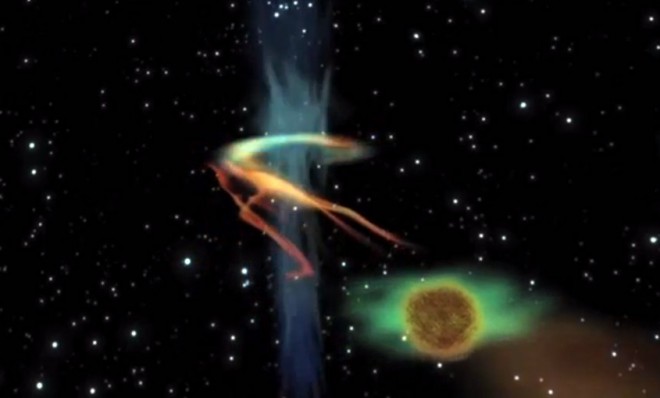WATCH: A massive black hole devours a super-Jupiter
The gas giant being picked apart is 14 to 30 times the size of Jupiter, the largest planet in our solar system

Black holes are, by their very nature, impossible to spot. Only when a cosmic sinkhole's immense gravitational pull begins sucking in nearby planets, gas, and light trying to outrace it do astronomers even begin to pinpoint one. But when they do, whoa boy.
Take this special case, 47 million light years away in the galaxy NGC 4845 — typically a quaint, quiet neighborhood, at least for the better part of the past two to three decades. Scientists were using the European Space Agency's Integral space telescope to observe another galaxy when they noticed some funny energy spikes emanating from NGC 4845's slice of suburbia.
What they saw was "completely unexpected," says study author Marek Nikolajuk of the University of Bialystok, Poland: An ultra-bright X-ray flare coming from a strange "halo of material." On subsequent inspections — and with some added eyes from NASA's Swift and Japan's MAXI X-ray monitors — astronomers realized what was actually happening: A long-dormant, supermassive black hole 300,000 times the size of our own sun was slowly ripping apart a gas giant 14 to 30 times the size of Jupiter; a feast of astronomical proportions.
The Week
Escape your echo chamber. Get the facts behind the news, plus analysis from multiple perspectives.

Sign up for The Week's Free Newsletters
From our morning news briefing to a weekly Good News Newsletter, get the best of The Week delivered directly to your inbox.
From our morning news briefing to a weekly Good News Newsletter, get the best of The Week delivered directly to your inbox.
According to SlashGear, the observable feeding frenzy "made the galaxy brighter by a factor of 1,000 in January 2011." The black hole apparently enjoys playing with its food, too. According to an ESA statement, "there was a delay of 2-3 months between the object being disrupted and the heating of the debris in the vicinity of the black hole." It took its sweet ol' time, in other words.
"This is the first time where we have seen the disruption of a substellar object by a black hole," says co-author Roland Walter of the Observatory of Geneva, Switzerland. "We estimate that only its external layers were eaten by the black hole, amounting to about 10 percent of the object's total mass, and that a denser core has been left orbiting the black hole."
A similar feast is on the horizon for another supermassive black hole in the middle of our own Milky Galaxy, possibly before the end of the year. "While there are no brown dwarfs or planets on the menu this time, a compact cloud of gas amounting to just a few Earth masses has been seen spiraling towards the black hole and is predicted to meet its fate soon," says the ESA.
Bon appétit.
A free daily email with the biggest news stories of the day – and the best features from TheWeek.com
-
 Mixed nuts: RFK Jr.’s new nutrition guidelines receive uneven reviews
Mixed nuts: RFK Jr.’s new nutrition guidelines receive uneven reviewsTalking Points The guidelines emphasize red meat and full-fat dairy
-
 Will regulators put a stop to Grok’s deepfake porn images of real people?
Will regulators put a stop to Grok’s deepfake porn images of real people?Today’s Big Question Users command AI chatbot to undress pictures of women and children
-
 ‘All of these elements push survivors into silence’
‘All of these elements push survivors into silence’Instant Opinion Opinion, comment and editorials of the day